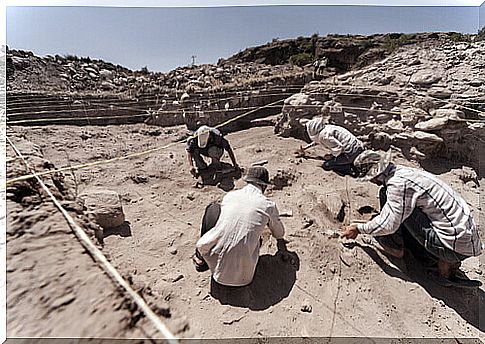A Prehistoric Dog In Murcia (Spain)

The story of man’s best friend has always fascinated us, which is why the discovery of a prehistoric dog in Murcia, a Spanish city, has aroused great interest.
In the Copper Age deposit of Caravaca de la Cruz, many interesting details have been found about our relationship with dogs during prehistoric times.
The field of the prehistoric dog
In this 4,000-year-old deposit, one of the largest burials in the prehistoric Iberian Peninsula, not only the remains of 1300 humans have been found, but also 25 specimens of prehistoric dogs. It is the same species that lives with us today, Canis lupus familiaris , and for the most part young specimens.
After more than four years of work, 2000 animal bones have been found, many of them canids: wolves and foxes joined the domestic dog, but skeletons of prehistoric pigs and horses also appeared.
The veterinarians of the University of Murcia studied the skeletons of these animals and this made it possible to verify that the teeth were very damaged. This data indicates that the animals probably ate mostly on bones.
The Anatomy Department of the University of Murcia was able to trace numerous data on the life of these animals simply by studying their bones.

The study of the bones made it possible to understand that most of the animals were medium in size, although some were larger. It would seem to be specimens of a breed, but the researchers are not unbalanced and prefer to talk about small morphotypes.
The height at the withers of these dogs averaged 50 centimeters, similar to the remains of other deposits from the same period. It is believed that these dogs mainly performed activities such as hunting and herding.
Fíbula, a special case
Fíbula, the name that received the oldest prehistoric dog in the field and whose skeleton has been reconstructed, attracted the attention of the researchers above all. The animal, which dates back to 4000 years ago, had a fracture in the right paw affecting the tibia and fibula.
The fracture had completely ossified, causing the leg to shorten. Researchers believe such a fracture was incompatible with a working dog’s activities such as a herding or hunting dog, as the animal had to limp quite a bit.

When Fíbula was alive, dogs had already been domesticated for several millennia. Nowadays the most widespread theory is that the friendliest and most confident wolves began to obtain various advantages by approaching the human population and feeding on its leftovers, supplanting the version in which the human being is the protagonist of the domestication of animals.
That of Fíbula is one of the many stories about the friendship between the inhabitants of the current region of Murcia in the Copper Age and a dog that had a long life thanks to the care of man. What other stories will this charming pet bring with him?









